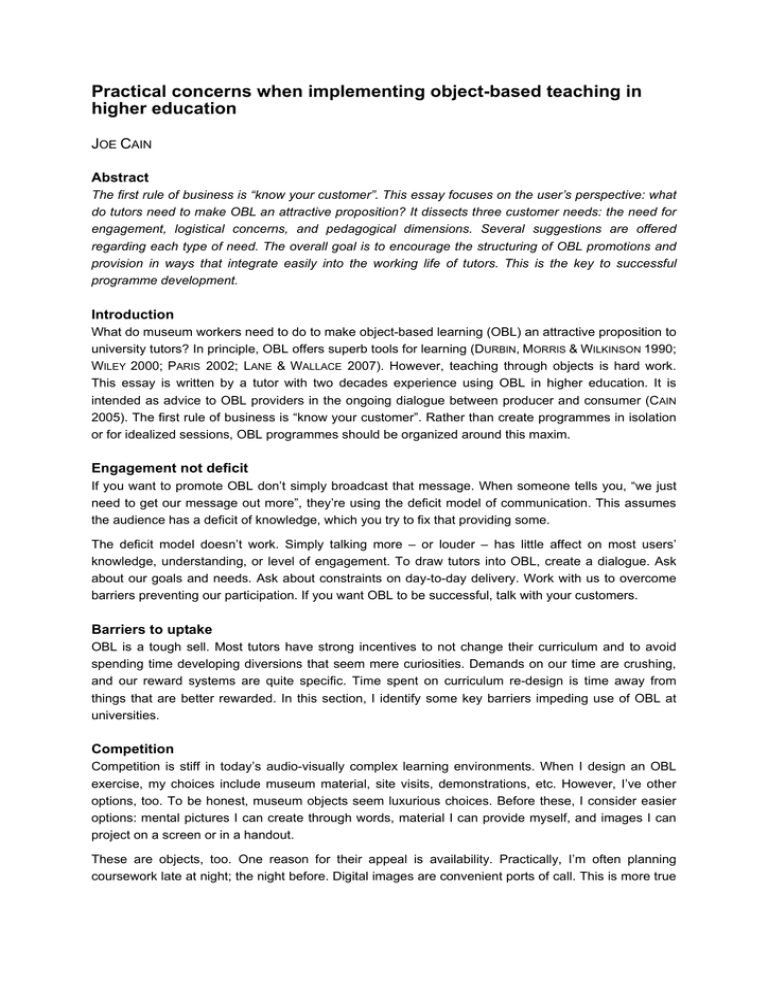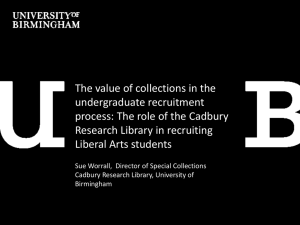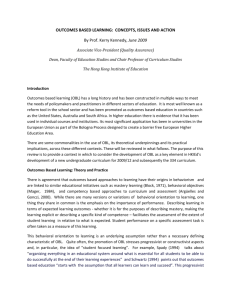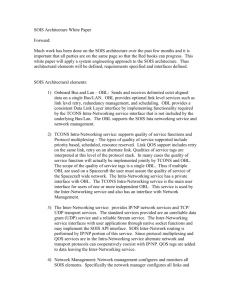Practical concerns when implementing object-based teaching in higher education J C
advertisement

Practical concerns when implementing object-based teaching in higher education JOE CAIN Abstract The first rule of business is “know your customer”. This essay focuses on the user’s perspective: what do tutors need to make OBL an attractive proposition? It dissects three customer needs: the need for engagement, logistical concerns, and pedagogical dimensions. Several suggestions are offered regarding each type of need. The overall goal is to encourage the structuring of OBL promotions and provision in ways that integrate easily into the working life of tutors. This is the key to successful programme development. Introduction What do museum workers need to do to make object-based learning (OBL) an attractive proposition to university tutors? In principle, OBL offers superb tools for learning (DURBIN, MORRIS & WILKINSON 1990; WILEY 2000; PARIS 2002; LANE & WALLACE 2007). However, teaching through objects is hard work. This essay is written by a tutor with two decades experience using OBL in higher education. It is intended as advice to OBL providers in the ongoing dialogue between producer and consumer (CAIN 2005). The first rule of business is “know your customer”. Rather than create programmes in isolation or for idealized sessions, OBL programmes should be organized around this maxim. Engagement not deficit If you want to promote OBL don’t simply broadcast that message. When someone tells you, “we just need to get our message out more”, they’re using the deficit model of communication. This assumes the audience has a deficit of knowledge, which you try to fix that providing some. The deficit model doesn’t work. Simply talking more – or louder – has little affect on most users’ knowledge, understanding, or level of engagement. To draw tutors into OBL, create a dialogue. Ask about our goals and needs. Ask about constraints on day-to-day delivery. Work with us to overcome barriers preventing our participation. If you want OBL to be successful, talk with your customers. Barriers to uptake OBL is a tough sell. Most tutors have strong incentives to not change their curriculum and to avoid spending time developing diversions that seem mere curiosities. Demands on our time are crushing, and our reward systems are quite specific. Time spent on curriculum re-design is time away from things that are better rewarded. In this section, I identify some key barriers impeding use of OBL at universities. Competition Competition is stiff in today’s audio-visually complex learning environments. When I design an OBL exercise, my choices include museum material, site visits, demonstrations, etc. However, I’ve other options, too. To be honest, museum objects seem luxurious choices. Before these, I consider easier options: mental pictures I can create through words, material I can provide myself, and images I can project on a screen or in a handout. These are objects, too. One reason for their appeal is availability. Practically, I’m often planning coursework late at night; the night before. Digital images are convenient ports of call. This is more true 198 · UMACJ 3/2010 now, with most classrooms capable of good projection. These options also allow me to work around other demands on my time and to change things quickly. Can your OBL programme do that? For context, I organize 80–100 lectures each year. I don’t have time to create ideal situations, and I can’t afford to spend large amounts of time preparing any single event. On a day-to-day practical level, ‘simplicity, availability and accommodation’ critically influence my decisions about OBL. Often, “good enough” simply must be good enough. That’s a ‘sufficiency’ criterion. If you want to prevent me from compromising with inferior choices, convince me your collaboration is not just better, but ‘phenomenally’ better. In addition, you’d be smart to build a system for access that accommodates impulse, topicality, and – frankly – me coming in with a line like “I’ve just had a great idea …”. You know which objects in your collection have relevance to current events. Help me make those connections. Logistics Logistical concerns are a second barrier. For OBL to be a good use of precious class time, it must work smoothly. As an example, imagine we organize a simple demo in a typical lecture theatre to demonstrate some old microscopes. Imagine, I want students literally to see what Enlightenment microscopists saw when using equipment from that period. While fantastic in theory, logistical concerns make me hesitate. Table 1 lists some of the concerns I’ll want sorted before agreeing to this OBL project. Visiting museums and other display spaces adds more concerns, listed in table 2. Of course, experienced museum workers will be familiar with many of these. Still, regardless how experienced ‘you’ are, your customers likely are novices. It’s ‘their’ sense of the problems that’s relevant in this case. The more you can support the logistical side of OBL, the more you’ll lessen these anxieties and the more effective will be your uptake. In the microscope example, I accept first-hand observation through real lenses as ideal. But I’ll settle for a few photographs, maybe also a video. These won’t be perfect, but they’ll be good enough under the constraints. Unless we can create something significantly better with OBL, I won’t be tempted. A different kind of learning OBL isn’t just about objects; it’s about teaching, too. It’s inextricably linked to criticisms of chalk-andtalk lecture styles and to the promotion of active, open-ended, student-centered learning. These connections cause a third barrier to OBL uptake. Many university tutors have a poor foundation in pedagogy. Most won’t have a clue what to do if the simple passive download model of lecturing was disallowed. Promotion of OBL asks for a radical change in teaching style. Anecdotally, I know a tutor who thinks students can’t learn while they’re talking. Another hates being interrupted for questions. Another sets as their goal the delivery of a certain amount of factual information. If they don’t meet their quota, they think students won’t have enough to give back on the exam. OBL asks for pedagogical skills these tutors simply don’t have. Don’t try to sell cars to people who don’t know how to drive. OBL arrives in a tutor’s life as a pair of ideas: something about objects and something about learning. If you want increase uptake, see OBL as a problem of two interlinking parts. Points for exploitation Towards some solutions, consider the following few suggestions: On competition, remember: a picture is worth a thousand words. Supplying images can be as useful for OBL as offering objects, demonstrations, or site visits. They’re not ideal; just good enough. Don’t Practical concerns when implementing object-based teaching · 199 think this need be a one-way relationship. I can use images from your collection to promote your collection. And ask me to register my use; I’m happy to tell managers and patrons how much this helps. On logistics, be flexible with the packages you offer. Site visits can be prohibitively demanding. A 5minute topical show-and-tell involves a different level of commitment compared with a 50-minute hands-on activity or a half-day site visit. Give me some options. Also, help me use time outside my already overcrowded two lecture hours each week. We might choose objects and displays I can recommend for informal viewing. Direct me to your events, and tell me what you’re planning. I can tweak these to fit my learning objectives. These spare me logistical problems. They also reward curiosity, initiative, and creativity by the students. I use your competition this way: films and walking tours, radio and television, newspapers and websites. Keep me in your advertising loops. Two ideas relate to pedagogical barriers. First, appeal to my frustration with the work students normally produce in their assignments. Remind me that regurgitation is a low-level cognitive skill and that I don’t have to encourage it. Show me examples of OBL so I can see its possible to have more than just a few students do something interesting, independent, and beyond rote repetition. After reading two dozen essays that look a lot like each other and are suspiciously close to an entry in some online source, believe me, I’m ready to listen. Some of the more tempting benefits of OBL, from the customer’s perspective, are listed in table 3. Second, think about your promotional strategies. Don’t simply tell me what you’re able to provide. Also, embed your OBL programme into processes tutors use for building curriculum and improving pedagogical skills. Place your OBL progamme at the centre of staff development courses, e.g., training courses in group work and student-centered learning. Or, offer training courses yourself. One persistent criticism of much staff development is the overuse of outside contractors. However talented, these people lack local knowledge. You don’t. That gives you a crucial advantage. Train your users in the skills they’ll need when using OBL, and do it with materials you make available. Teach me to drive in the car you want me to buy. Conclusion In sum, four points are key. First, abandon the deficit model for communicating information about OBL. It doesn’t work. Second, focus on the customer’s perspective. Understand barriers as we tutors conceive them. Third, remember some barriers have nothing to do with the objects themselves. There’s stiff competition, and logistical concerns can overwhelm. Plus, OBL asks a lot of tutors. If you don’t support the whole package, you’ll be offering only half a solution. It’s easy to cherry-pick in OBL, using extraordinary material carefully prepared, with highly motivated and specially supported tutors, then delivered to selected populations of overly eager students. It’s quite another matter to roll out changes across a whole teaching programme or across a whole institution within the practical constraints of normal work. I know firsthand how OBL turns people on to learning, especially when all else fails. I also know it’s hard, skilled work. We tutors are grateful for the work museum people do to promote it and to create more. With careful attention to our practical needs, OBL provision can be made all the more effective and widespread. Acknowledgements Thanks to staff at the UCL Grant Museum of Zoology for their encouragement and advice. 200 · UMACJ 3/2010 Literature cited BALLANTYNE, N. & A. KNOWLES 2007. Enhancing Student Learning with Case-based Learning Objects in a Problem-based Learning Context: The Views of Social Work Students in Scotland and Canada. MERLOT Journal of Online Learning and Teaching 3: 363–374. CAIN, J. 2005. Teaching through objects: a User's perspective. NATSCA News 7: 2–7. DURBIN, G., S. MORRIS & S. WILKINSON 1990. Learning from objects: A teachers guide. London: English Heritage. LANE, J. & A. WALLACE 2007. Hands On: Learning from Objects and Paintings. A Teacher’s Guide. Glasgow: Scottish Museums Council. PARIS, S.G. (ed.) 2002. Perspectives on object-centered learning in museums. New York: Routledge. ULRICH, R. S. 1984. View through a window may influence recovery from surgery. Science 224: 420– 421. WILEY, D. A. (ed.) 2000. The instructional use of learning objects. Bloomington: Indiana Association for Instructional Technology and Association for Educational Communications and Technology. Contact Dr Joe Cain Senior Lecturer in History and Philosophy of Biology Address: Department of Science and Technology Studies, University College London, Gower Street, London WC1E 6BT, United Kingdom E-mail: J.Cain(at)ucl.ac.uk www.ucl.ac.uk/sts/cain Table 1. Some logistical concerns raised by the tutor in a case study of OBL in a traditional lecture theatre Setting – Can I get this delivered to the lecture theatre? Timing – I only have 50 minutes in the room. Can I ensure the activity is delivered, setup, explained, done, and packed in time? Plus, we need time to process, interpret, discuss, and contextualize. Access – All students need time with the objects, plus time to move around. Most teaching rooms are designed for sitting not circulating. People management – What will the other students be doing when not using the objects? intellectual groundwork – What background knowledge do students need? What needs to happen for them to take away the maximum impression? When am I going to do this preparation with them? Settling in – Novices experience objects differently than experts do. How much orientation time is required? How do I isolate their attention onto what I want them to focus on, rather than distractions? Do I build in time for play and open-ended discovery? Trust – Class time is precious. Time spent in OBL must ‘in fact’ move us towards my course objectives. It also must ‘be seen to move us’ forward. I need to be confident students will feel the work is relevant. I rely on them trusting me on this point, and I won’t risk breaking that trust. Recording – What do students preserve from the experience? How will they recall it later, or reflect on it, or build on it? What note-taking needs to be done? Shut off – When I’m done with the objects, I’ll want to move on. I need effective transitions. If I can’t put an object away immediately, or move attention off it, I might as well not move on. Follow-up and back-up – What happens when students want more – e.g., for revision or for those who were absent? I need effective substitutes. Practical concerns when implementing object-based teaching · 201 Co-ordination with other courses – Have students done this before? Will it be useful elsewhere in their degree? Can I double-up and involve other courses? Tutor’s often don’t share information; how much time is it going to take to negotiate this with colleagues? Table 2. Some logistical concerns raised by the tutor in a case study of OBL when learning is moved away from the assigned rooms, e.g., to a museum (access and risk assessment are assumed) Alternate location – I need to sort instructions and work to ensure students receive these repeatedly, especially novices. Will weather be a factor? ~Any transport costs? If this doesn’t take a whole period, what am I going to do with the remainder of my time? Timing – I need to ensure students can arrive, work, and leave in the time slot I am assigned, anticipating where they are coming from and going to with time to spare. I don’t take kindly to other tutors running into my time; neither do my colleagues. Physical environment: Where are the toilets, the seating areas, the places to put coats and bags? What are the security and meeting point needs? Co-ordination on the day – If other staff are involved, do they know what I’m trying to accomplish? Are we working to the same plan? Do I know what I need for preparation? Have I given myself time to prepare others and for post-match analysis? Table 3. Reasons a tutor might be persuaded to introduce OBL projects both in course sessions and to replace coursework based on rote assembly of information 1. Students increase self-awareness and engagement during breaks in their minute-to-minute and course-to-course routine. 2. Students encouraged to be curious are easier to teach, do more work, ask more interesting questions, and – frankly – write more thought-filled essay. 3. Memory is complicated. Some people process texts and facts well; others work better through images, spatial thinking, sensory inputs, and so on. Each dimension has value in learning. 4. Intelligence is complicated, too, including layers related to linguistic, logical-mathematical, spatial, musical, kinesthetic, inter-personal, and intra-personal capacities. 5. OBL can exploit time outside the schedule for informal learning, thereby complementing or supplementing formal learning in the course. 6. Students prefer multimedia and multisensory experiences when learning (BALLANTYNE & KNOWLES 2007). 7. Indirect benefits can accrue. For instance, in a study of hospital patients, those with a view of a natural outside scene from their beds recovered faster than those with a view of brick walls (ULRICH 1984). 202 · UMACJ 3/2010





